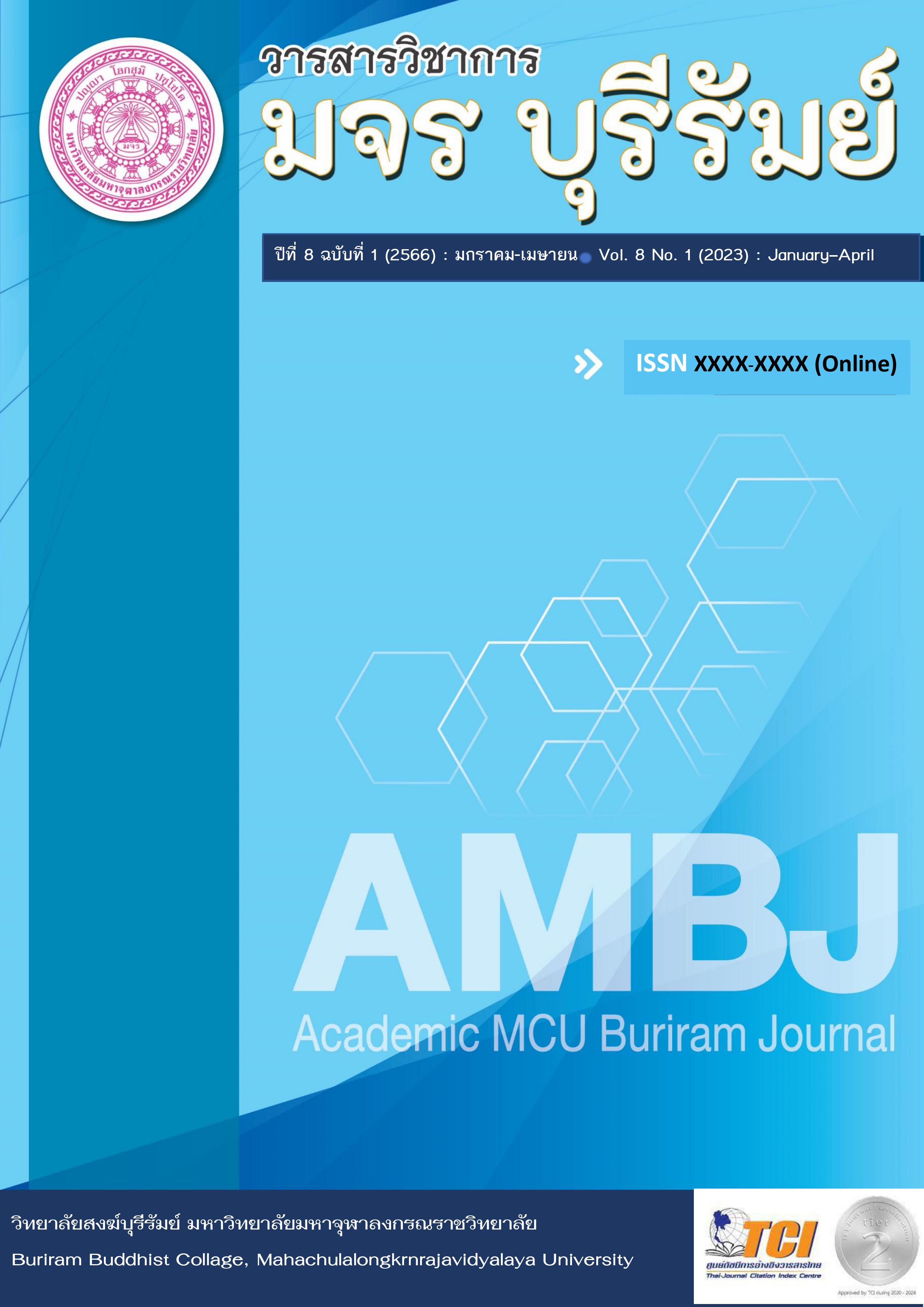Interpretation of Concept of Garuda in Theravada Buddhist Philosophy
Keywords:
Interpretation, Garuda, Theravada Buddhist PhilosophyAbstract
This purpose of this research were: 1) study of Garuda in Theravada Buddhist Philosophy, 2) study of hermeneutic and works on Theravada Buddhist Philosophy, and 3) study of interpretation of concept of Garuda in Theravada Buddhist Philosophy. This research is a documentary research. The data are collected from the Tripitaka and related research on interpretation of concept of Garuda in Theravada Buddhist Philosophy. Then, the data has been collected and analyzed and synthesized in order to obtain the objective knowledge.
The research result found that:
Garuda in Theravada Buddhist philosophy is a type of lower angel. They abide in Wiman Chimphli (The castle of the opera tree), eat Nak as food, and are the follower of Virulhok God. It is believed that Garuda is born from person who makes a merit, mixing with delusion and misbelieves that killing the other animals is no sin. Therefore, that result brings itself to be reborn a Garuda. The origin of Garuda can be 4 methods; being birth automatic, rising up in womb, in egg and an ash (wet conditions). The abode of Garuda is Himavanta Forest, foothill of Sineru Mountain and Catumaharajika Heaven (First Paradise). The physical feature of the Garuda is a sharp beak, half man and half bird, long wings and big body. They can fly fast in the air, when flying, there is a big storm. Garuda is hostile to Nak. The duty of Garuda is to protect Buddhism and save the moral people. Moral of Garuda is humble, hold the truth and be gratitude. Marvelous Mantra of Garuda is called Alampayana. Hermeneutic and studying works on Theravada Buddhist Philosophy are a key to be Interpretation. It makes understanding the text and explain meaning correctly. The eastern hermeneutic called Buddhist Interpretation, using interpretation on Buddhist text named Nettipakarana. This text is a key of Buddhist interpretation as follows; 16 Haras, 5 Nayas and 16 Sasanapathanas. Those methods are used to interpret on concept of Garuda of Theravada Buddhist philosophy both clarification and intermediation.
Having interpreted on concept of Garuda of Theravada Buddhist philosophy, finds that Garuda in Theravada Buddhism is classified into 2 categories: 1) personification type; it means a sort of animal, a half god and half bird shape, aboding in Wiman Chimphli, eating nak as food, being an enemy to nak, being the retinues of Virulhok God and lives at Catumaharajika Heaven. The origin of Garuda can be 4 methods; being reborn automatic, rising up in womb, in egg and an ash. And 2) exposition in Dhamma type; it means mental principle, being faith in monks, being like to make merit, observing precepts and normally cultivating meditation. On the other hand, it means bad mental principle, following defilement and composing with delusion. It misbelieves that killing other animals is not sin. It likes to be vengeful jealousy of others. A concept of Garuda of Theravada Buddhist philosophy is not eternal life and not a magician. Garuda must circulate with being reborn and death endless.
References
ธิดา มิตรกูล. (2527). ศึกษาคติความเชื่อครุฑจากศิลปกรรมแบบเขมรในประเทศไทย. วิทยานิพนธ์ปริญญาศิลปศาสตรมหาบัณฑิต. บัณฑิตวิทยาลัย: มหาวิทยาลัยศิลปากร.
ปรุตม์ บุญศรีตัน. (2550). วิเคราะห์รูปแบบการตีความในคัมภีร์พุทธศาสนาเถรวาท. วิทยานิพนธ์ปริญญาพุทธศาสตรดุษฎีบัณฑิต. บัณฑิตวิทยาลัย: มหาวิทยาลัยมหาจุฬาลงกรณราชวิทยาลัย.
พระคึกฤทธิ์ โสตฺถิผโล. (2558). พุทธวจนะ ฉบับภพภูมิ. กรุงเทพมหานคร: อินเทรนด์.
พระมหาสมบูรณ์ วุฑฺฒิกโร. (2556). เอกสารประกอบการบรรยายเรื่องศาสตร์แห่งการตีความแนวพุทธ. กรุงเทพมหานคร: มหาจุฬาลงกรณราชวิทยาลัย.
พญาลิไท. (2509). ไตรภูมิพระร่วง. กรุงเทพมหานคร: พระนคร.
พระสมพร สมจิตฺโต (เย็กรัมย์). (2557). การศึกษาครุฑในคัมภีร์พุทธศาสนาเถรวาท. วิทยานิพนธ์ปริญญาพุทธศาสตรมหาบัณฑิต. บัณฑิตวิทยาลัย: มหาวิทยาลัยมหาจุฬาลงกรณราชวิทยาลัย.
มหาวิทยาลัยมหาจุฬาลงกรณราชวิทยาลัย. (2539). พระไตรปิฎกภาคภาษาไทย ฉบับมหาจุฬาลงกรณราชวิทยาลัย. กรุงเทพมหานคร: มหาจุฬาลงกรณราชวิทยาลัย.
ยมโดย เพ็งพงศา. (2521). ศึกษาวิเคราะห์ครุฑและนาคในวรรณคดีบาลีและสันสกฤต. วิทยานิพนธ์ปริญญาอักษรศาสตรมหาบัณฑิต สาขาวิชาจารึกตะวันออก. บัณฑิตวิทยาลัย: จุฬาลงกรณ์มหาวิทยาลัย.
ราชบัณฑิตยสภา. (2542). พจนานุกรมราชบัณฑิตยสถาน. กรุงเทพมหานคร: นานมีบุคส์.
วีรชาติ นิ่มอนงค์. (2552). ทฤษฎีอรรถปริวรรตศาสตร์ในคัมภีร์พุทธศาสนาเถรวาท. รายงานการวิจัย. สถาบันวิจัยพุทธศาสตร์: มหาจุฬาลงกรณราชวิทยาลัย.
ศานติ ภักดีคำ. (2556). ครุฑ. กรุงเทพมหานคร: อมรินทร์.
ศักดิ์ศรี แย้มนัดดา. (2521). ศึกษาวิเคราะห์เรื่องครุฑในวรรณคดีสันสกฤต. วิทยานิพนธ์ปริญญาอักษรศาสตรมหาบัณฑิต สาขาจารึกตะวันออก. บัณฑิตวิทยาลัย: จุฬาลงกรณ์มหาวิทยาลัย.
สมบัติ พรศิริเจริญพันธ์. (2559). เฮอร์เมนูติกส์และศาสตร์แห่งการตีความและศิลปะแห่งการเข้าใจ. กรุงเทพมหานคร: วัชรินทร์.
Downloads
Published
How to Cite
Issue
Section
License
Copyright (c) 2023 Academic MCU Buriram Journal

This work is licensed under a Creative Commons Attribution-NonCommercial-NoDerivatives 4.0 International License.
ทัศนะและความคิดเห็นที่ปรากฏในบทความวารสารฉบับนี้ถือเป็นความรับผิดชอบของผู้เขียนบทความนั้น ไม่ถือเป็นทัศนะและความรับผิดชอบของบรรณาธิการ





